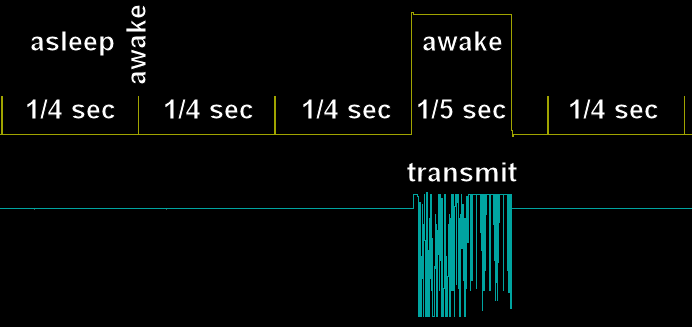Power usage depends on the current of any sensors that you add, as well as how often you configure LoFi to check sensors and transmit. Transmitting consumes approximately 15 mA. Not transmitting, but constantly checking the sensors, consumes about 0.5 mA.
A more likely scenario for battery operation is where LoFi transmits sensor data periodically or is activated by a trigger switch, say every 10 minutes. In that case, LoFi sleeps most of the time. As you will see, this allows for extremely long battery life.
This weekend, I coded and tested the sleep mode. LoFi uses the ATtiny watchdog to wake every 1/4 of a second to check whether it is time for a periodic transmission. It also examines the receive pin to see if someone is trying to configure the device. The digital trigger input (which can be connected to vibration or door switches) does not require polling. Instead, it will wake the device immediately.
On the oscilloscope trace below, you can see LoFi wakes up briefly (narrow vertical spikes) before falling back to sleep. Each spike takes about 4.3 ms (oscillator start up + computations). Then, the transmit time occurs and LoFi takes about 200 ms to read the sensors and transmit the data.

If a transmission occurred every 10 minutes, here is the average current draw:

Only 18.5 microamps – thank you Atmel! Plug that into some common batteries:

So, theoretically, you could run LoFi from a coin cell for a year. If you add a diode, capacitor, and small solar panel, then the life of the coin cell could be extended, as it would act as a backup at night. Realistically, with a pair of AA cells, you could forget about it for many, many years.
Best of all, since LoFi includes the power supply voltage in the sensor data, you’ll know when it is time to change the batteries.
 David Cook
David Cook
Discussions
Become a Hackaday.io Member
Create an account to leave a comment. Already have an account? Log In.
No, if you have a 1Ah (or 1000 mAh) battery and 1A (1000mA) power consumption it will last for 1 hour. ( 1Ah / 1A = 1 hour)
So, if the CR2032 battery has a capacity of 200mAh and you have a consumption of 18.5uA (MICROamps) it will last 10811 hours or 450 days ( 200 mAh / 0.0185 mA ) / 24 hours per day = 450 days
Are you sure? yes | no
Hi, I do not understand the calculation of battery life .
You're dividing mAh / mAsec , this is good ?
Do not you would have to calculate the hourly consumption that is 0.018547 * 60 = 1.11282mA
And then using the CR2032 : 200 / 1.11282 = 179.72 hours
Regards
Are you sure? yes | no
A 3000mAH, rated voltage 5V battery is powered by a 2.5W, 5V power supply. Its theoretical duration is:
I=P/U=>2.5w/5v=>0.5A=>500MA
3000mAh, that is, 3000MA current can be discharged for one hour.
3000/500=6 hours
Are you sure? yes | no